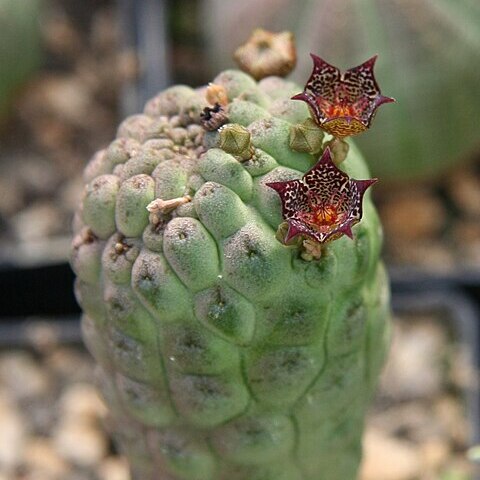Dwarf shrub with 3-30 stems, branching from base. Stems 30-150 mm long, 20-55(-65) mm thick, erect to spreading, cylindrical clavate or ovoid; tubercles flattened rounded polygonal, crowded but arranged into ±12-19 rows along stem, each tipped with small conical to flattened leaf-rudiment <1 mm long seated in a small depression. Inflorescences mainly in upper parts of stem but sometimes evenly spread over plant, with flowers in groups of 1-5, developing successively; pedicel ±1 mm long, 1 mm thick; sepals 1.5-2.0 mm long, 1 mm broad at base, ovate, acute. Corolla 8-16 mm diam., campanulate to ± rotate; outside green spotted with reddish; inside variously mottled with red to dark red-brown on cream background, sometimes nearly uniformly dark purple-brown (in north), smooth; tube 0.5-3.0 mm deep, very shallowly saucer-like to cupular, with corolla scarcely to not at all thickened at mouth; lobes 2-5 mm long, 3-5 mm broad at base, spreading, often with recurved tips, broadly ovate-deltate, acute, margins slightly to not at all recurved. Corona 2-3 mm tall, 3.5-4.5 mm broad, irregularly spotted and lined with pink to maroon on cream background, often with droplets of nectar accumulating on upper surfaces, sessile; outer lobes 1.5-2.0 mm long, ascending, bifid to well below middle into slender sometimes nearly terete widely divergent spreading to ascending obtuse lobules, laterally fused towards base with bases of inner lobes to form pouch; inner lobes 1.5-2.0 mm long, adpressed to backs of anthers and exceeding them then connivent-erect and rising into column in centre sometimes diverging at tips, linear, obtuse, occasionally with small obtuse dorsal projection near base and in series with outer lobes.
More
A herb or shrub that lies along the ground. It is succulent and keeps growing from year to year. It grows 15 cm high. The stems are 3-15 cm long and 2-6 cm thick. The flowers are in the upper parts of the stems. They are in groups of 1-5. They are yellow with red or purple marks. They are saucer shaped. The fruit are long, horn like pods.
Like L. cactiformis but stems often branching from base to form clumps of up to 30, corolla smooth inside.
It is a subtropical plant. It grows in hot arid places. It grows in places with a marked dry season. The dry season can be 6-11 months. It grows in well-drained sandy soils and amongst rocks. In southern Africa it grows below 1,000 m above sea level. It can grow in arid places.

